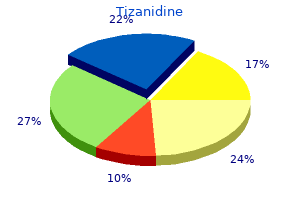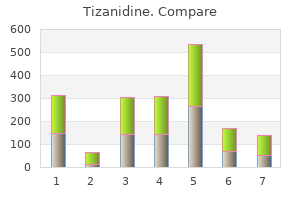Tizanidine
"Generic tizanidine 2mg with mastercard, spasms near gall bladder".
By: K. Kliff, M.B. B.CH. B.A.O., M.B.B.Ch., Ph.D.
Associate Professor, Louisiana State University
For instance muscle relaxant blood pressure discount 2 mg tizanidine overnight delivery, a 40-year-old who is assaulted physically is less likely than a three-year-old to develop attachment problems muscle relaxant suppository buy 2mg tizanidine with mastercard. Depending on their age and developmental stage muscle relaxant tv 4096 cheap tizanidine 2 mg free shipping, children have less well-developed linguistic muscle relaxant medications back pain order tizanidine master card, affect regulation, cognitive and perceptual capacities than adults. Naturally, these developmental limitations will influence the nature of treatment and the manner in which it is delivered. General Considerations when Working with Children and Adolescents 52 Trauma and trauma reactions Trauma, traumatic event and potentially traumatic event As noted in the previous chapter, the terms trauma, traumatic event, and potentially traumatic event are used in a variety of ways. By no means do all young people exposed to such events develop significant psychological problems. Increasingly, however, in the field of children and adolescents (especially preschool-aged children) this focus is broadening to include behavioural and attentional problems (such as oppositional defiant disorder and attention deficit hyperactivity disorder). Clinical presentations in children and adolescents following potentially traumatic events Yule6 described the manifestation of traumatic stress responses in children and adolescents in a manner that has withstood the test of time and burgeoning research. He noted that, while the majority of children are bothered almost immediately by repetitive, intrusive thoughts about the event, dissociative flashbacks are not common. As in adults, irritability, anger and aggression are common, often manifested as temper tantrums in preschool-aged children. Many primary school-aged children and adolescents are able to articulate a desire to talk about their experiences, but also note that they find it difficult to speak about what happened with their parents and peers. Children and adolescents frequently report, and demonstrate, difficulties in concentration and memory. Hypervigilance to danger in their environment (including increased awareness of traumarelated reminders in the media) is typical. Primary school-aged children and adolescents often endorse a sense of foreshortened future, or what is perhaps more usefully viewed as a new awareness of their own mortality. Other important aspects of clinical presentation in preschool-aged children that were not explicitly described by Yule include new oppositional behaviour, regression in, or loss of, previously mastered developmental skills. Rather, the clinician is required to apply the same criteria as those used for adults, albeit sometimes with minor adjustments. Thus, the full adult-centric diagnostic criteria will not be reviewed here (see previous chapter for the diagnostic criteria). One of the strongest criticisms of the criteria concerns the requirement for children to report on complex internal states. Importantly, it has been demonstrated that there is no difference in terms of distress, or social and academic impairment, between children meeting full criteria. Research has demonstrated these symptom profiles following disaster,12,13 terrorist attack,14 and exposure to domestic violence. The studies that have been conducted have focussed on samples of youth involved in motor vehicle accidents and single assaults, with relatively low prevalence rates reported: 8 per cent;23 19 per cent;24 and 9 per cent. Of the adolescents on board, 217 agreed to participate in an assessment conducted between five and eight years after the event. A wide range of adverse health consequences for pre-schoolers through to adolescents has been identified,e. Recently, two very long-term follow-ups of children who experienced a landslide and bushfire disaster were reported. This group was compared with matched controls recruited at the time of the original study. In fact, the only difference in terms of lifetime rates for an individual disorder was specific phobia (environmental subtype), with this being more prevalent in the disaster-impacted sample. Interestingly, however, 30 per cent of the bushfire-impacted sample nominated the bushfire as the worst experience of their life. Referring back to the long-term follow-up of the Jupiter survivors,43 52 per cent of the adolescents (mean age 14. Small-to-medium effect sizes were found for the following risk factors: being female, low intelligence, low socioeconomic status, pre- and post-trauma life events, pre-trauma low self-esteem, pre-trauma psychological problems in the youth and parent, post-trauma parental psychological problems, bereavement, time elapsed since the trauma event, trauma severity, and media exposure to the event.

One thing to keep in mind for for loops in R: the computation of this is fastest if we first make a holder for the output muscle relaxant pregnancy safe cheap 4 mg tizanidine free shipping. Here I simulate a random walk muscle relaxant nursing tizanidine 4mg overnight delivery, where spasms treatment buy 2 mg tizanidine mastercard, for instance muscle relaxant drug list cheap tizanidine online mastercard, we start with 25 individuals at time = 0, and increase or decrease by some amount that is drawn randomly from a normal distribution, with a mean of zero and a standard deviation 2. A common example in ecology is to collect repeated measurements of an experimental unit and enter the data into multiple columns of a spreadsheet, creating a wide format. They are currently structured as longitudinal data; here we rearrange them in the wide format, as if we record uptake seven sequential observations on each plant in different columns. If we import the data in this format, we would typically like to reorganize it in the long format, because most analyses we want to do may require this. We will need, however, to define groups differently, by creating the interaction of the two factors. When we summarize data, as in tapply, we often want the result in a nice neat data frame. Its use is a bit like tapply - you provide (i) the numeric columns of a data frame, or a matrix, (ii) a list of named factors by which to organize the responses, and then (iii) the function to summarize (or aggregate) the data. I typically use the reshape package (with functions melt and cast), rather than the reshape function supplied in the stat. Here we start with the latter (referred to as writing data), and finish with the former (referred to as reading data). Here I create a data frame of numbers, and write it to a text file in two different formats. The first is a file where the observations in each row are separated by tabs, and the second separates them by commas. For the normal distribution, for instance, there are four functions: dnorm the probability density function, that creates the widely observed bellshaped curve. To do this, we need to use numerical techniques that turn the infinitely small steps of calculus, dx, into very small, but finite steps, in order to approximate the change in y, given the change in x, or dy/dx. Mathematicians and computer scientists have devised very clever ways of doing this very accurately and precisely. In R, the best package for this is deSolve, which contains several solvers for differential equations that perform numerical integration. This function, ode, is a "wrapper" for the underlying suite of functions that do the work. For instance, we say that we solve the logistic growth model for time at t = 0, 1. The arguments for the function must be time, a vector of populations, and a vector or list of model parameters. I also like to use with which allows me to use the names of my parameters [157]; this works only is p is a vector with named paramters (see below). Because we are using a vector of named parameters, we need to make sure we name them! The output is a matrix, with the first column being the time steps, and the remaining being your state variables. For instance, the function extracts the the first element of r for the first species (r[1]); for the intraspecific competition coefficient for species 1, it uses the element of a that is in the first column and first row (a[1,1]). The vector of population sizes, N, contains one value for each population at one time point. Thus here, the vector contains only two elements (one for each of the two species); it holds only these values, but will do so repeatedly, at each time point. To integrate these populations, we need to specify new initial conditions, and new parameters for the two-species model. In addition, it has several bells and whistles that we will not need to take advantage of here, although I will mention one, hmax.
Purchase cheap tizanidine on line. Muscle Relaxers - Should I Take Muscle Relaxers by Carrollwood Chiropractic Center.

Syndromes
- National Heart, Lung, and Blood Institute - www.nhlbi.nih.gov/health/dci/Diseases/cf/cf_what.html
- Isoniazid
- Finasteride (Propecia, Proscar, Avodart)
- Bluish skin, lips, or fingernails
- Had a moderate to severe reaction after a previous flu vaccine
- Remove fluid or tissue that presses on the spinal cord (decompression laminectomy)
- Serum potassium
- Complete blood count (CBC)

